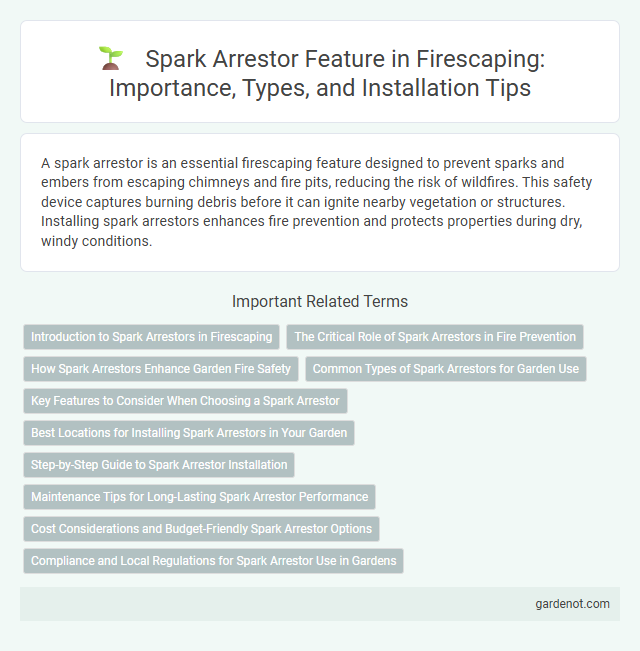A spark arrestor is an essential firescaping feature designed to prevent sparks and embers from escaping chimneys and fire pits, reducing the risk of wildfires. This safety device captures burning debris before it can ignite nearby vegetation or structures. Installing spark arrestors enhances fire prevention and protects properties during dry, windy conditions.
Introduction to Spark Arrestors in Firescaping
Spark arrestors are essential components in firescaping, designed to prevent the emission of burning embers or sparks from fireplaces, chimneys, or fire pits. These safety devices typically consist of metal mesh screens that trap sparks, reducing the risk of wildfires and property damage in fire-prone landscapes. Proper installation and maintenance of spark arrestors enhance fire safety by minimizing ember escape and helping contain outdoor fires.
The Critical Role of Spark Arrestors in Fire Prevention
Spark arrestors play a crucial role in fire prevention by effectively trapping and containing embers and sparks emitted from chimneys, stoves, and outdoor fire pits. These devices reduce the risk of wildfires by preventing hot particles from escaping and igniting surrounding vegetation or structures. Installing a high-quality spark arrestor is essential in maintaining safer outdoor environments, especially in fire-prone areas.
How Spark Arrestors Enhance Garden Fire Safety
Spark arrestors prevent embers and sparks from leaving outdoor fire pits or fireplaces, significantly reducing the risk of garden fires. By capturing flying debris, they protect surrounding vegetation and structures from accidental ignition. Effective spark arrestors are essential components for maintaining a safer outdoor fire environment and minimizing wildfire hazards.
Common Types of Spark Arrestors for Garden Use
Common types of spark arrestors for garden use include wire mesh screens, baffle-style arrestors, and centrifugal spark arrestors. Wire mesh screens prevent sparks by filtering out embers through fine metal grids, while baffle-style arrestors use internal plates to disrupt and cool sparks. Centrifugal spark arrestors leverage airflow to separate and trap sparks before they exit chimneys or garden stove flues, enhancing fire safety in outdoor environments.
Key Features to Consider When Choosing a Spark Arrestor
Key features to consider when choosing a spark arrestor include material durability, ensuring resistance to corrosion and high temperatures, and mesh size, which must be fine enough to trap sparks while allowing optimal airflow. The arrestor's ease of installation and maintenance also plays a critical role in its efficiency and longevity. Certifications meeting regulatory standards for fire prevention further guarantee the device's effectiveness in reducing wildfire risks.
Best Locations for Installing Spark Arrestors in Your Garden
Installing spark arrestors near fire-prone areas such as woodpiles, compost bins, and outdoor fireplaces significantly reduces the risk of accidental garden fires. Positioning them close to ventilation openings of garden sheds and near chimneys ensures that sparks are effectively captured before escaping into the environment. Placing spark arrestors around dry grass patches and mulch beds adds an essential layer of fire prevention in high-risk zones of your garden.
Step-by-Step Guide to Spark Arrestor Installation
Installing a spark arrestor requires selecting the correct size for your fireplace or wood stove to ensure effective spark containment. Begin by turning off and cooling the appliance, then securely attach the spark arrestor mesh screen to the chimney or stovepipe outlet using screws or clamps. Regularly inspect and clean the spark arrestor to prevent blockages and maintain optimal airflow, reducing the risk of chimney fires caused by escaping embers.
Maintenance Tips for Long-Lasting Spark Arrestor Performance
Regularly inspect the spark arrestor for soot and debris buildup to prevent clogs that reduce effectiveness. Clean the mesh screen using a wire brush or compressed air to maintain optimal airflow and spark-catching capability. Replace the spark arrestor if the mesh shows signs of rust or damage to ensure continuous fire safety and compliance with regulations.
Cost Considerations and Budget-Friendly Spark Arrestor Options
Spark arrestors play a crucial role in preventing wildfire ignitions by capturing embers from chimneys and stovepipes, making cost considerations essential for effective firescaping. Budget-friendly options typically include galvanized steel or mesh spark arrestors, which provide reliable ember control at a lower price point compared to more durable stainless steel models. Homeowners can maximize fire safety while minimizing expenses by selecting spark arrestors that balance affordability with compliance to local fire codes and durability requirements.
Compliance and Local Regulations for Spark Arrestor Use in Gardens
Spark arrestors are essential for firescaping compliance, ensuring garden fireplaces, fire pits, and wood stoves meet local fire safety regulations designed to prevent wildfire ignition. Many municipalities mandate spark arrestors with specific mesh sizes and installation standards to reduce the emission of embers and sparks into dry vegetation. Proper use and maintenance of spark arrestors not only aligns with regulatory requirements but also significantly mitigates the risk of garden fires in wildfire-prone areas.
Spark arrestor feature Infographic

 gardenot.com
gardenot.com